AVERAGE function - The function returns the average of the arguments in Excel
The following article introduces you to the AVERAGE function - one of the functions in the statistical function group is very popular in Excel.

Description: The function returns the average of the arguments.
Syntax: AVERAGE (number1, [number2], .)
Inside:
- number1, number2 . are the values you want to calculate the average absolute deviation, where number1 is the required parameter, the remaining number values are optional. The function contains up to 255 number values .
Attention:
- AVEDEV function is affected by the measurement unit of input data.
- The values of the arguments must be either numbers or names or references that contain numeric values.
- When typing logical values directly and displaying text numbers in functions, these values will be calculated.
- Parameter values or arrays that are logical values, text or blank cells are ignored.
- In case you want to calculate the logical values and numerical expressions written in the function, you should use AVERAGEA function .
- If you want to calculate the average of the values that meet certain conditions, you should use the AVERAGEIF function or the AVERAGRIFS function .
For example:
Calculate the average of the values in the following data table:
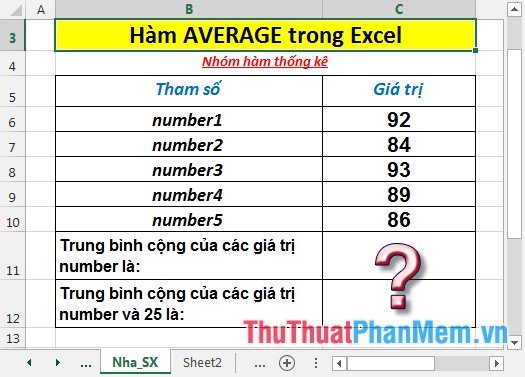
- Calculate the average of the number values in the data table. In a cell to calculate enter the formula: = AVERAGE (C6: C10)
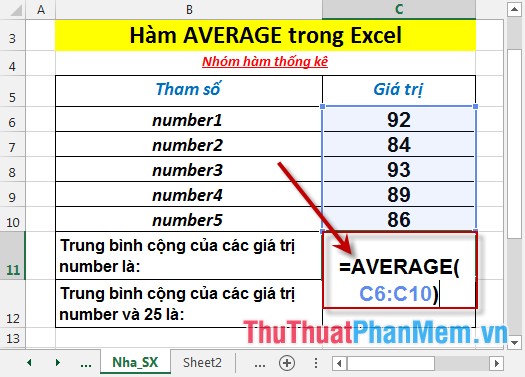
- Press Enter -> average of number values is:
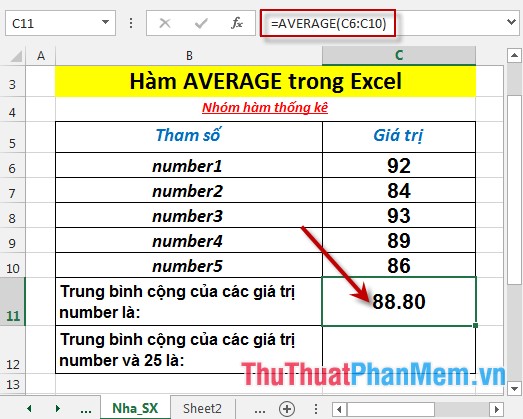
- Calculate the average of the values of number and 25 -> enter the formula: = AVERAGE (C6: C10,25)
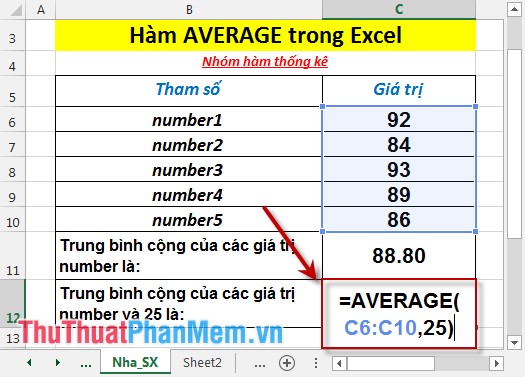
- Press Enter -> the average of the values of number and 25 is:
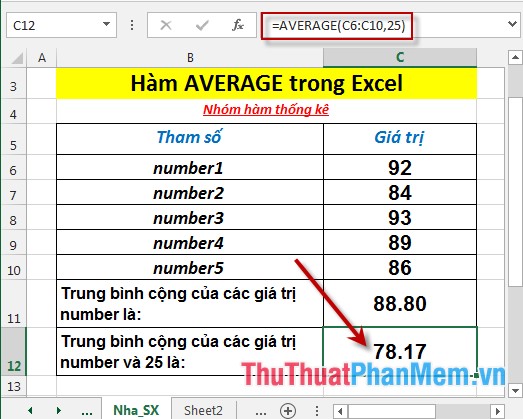
- Where number values are blank cells or text -> they are ignored.
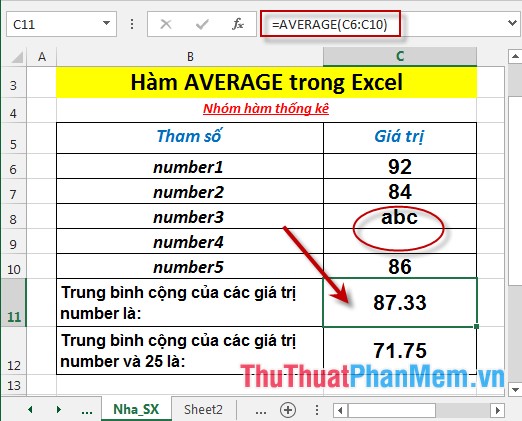
Above are instructions and specific examples when using the AVERAGE function in Excel.
Good luck!
You should read it
- How to use the DAVERAGE function in Excel
- AVERAGEA function - The function returns the average of the arguments including numeric, text, and logical values in Excel
- TRIMMEAN function - The function returns the average of the inner part of a dataset in Excel
- GEOMEAN function - The function returns the average of a positive array or range of data in Excel
- Basic Excel functions that anyone must know
- AVEDEV function - The function returns the average absolute deviation of data points from their midpoint in Excel
- Average function (calculate the average) in Excel
- AVERAGEIF function (returns the average value according to the condition) in Excel
May be interested
- Basic Excel functions that anyone must know
 the basic functions in excel such as the excel function, the excel statistics function we summarized below will be very helpful for you who often have to work on excel spreadsheets, especially in the field of accounting. let's refer to offline.
the basic functions in excel such as the excel function, the excel statistics function we summarized below will be very helpful for you who often have to work on excel spreadsheets, especially in the field of accounting. let's refer to offline. - WEIBULL function - The function returns the Weibull distribution in Excel
 the function performs the calculation and returns the weibull distribution. based on this distribution to analyze reliability in theory such as calculating the average life of the device or used in the field of meteorology, hydrology and weather forecast.
the function performs the calculation and returns the weibull distribution. based on this distribution to analyze reliability in theory such as calculating the average life of the device or used in the field of meteorology, hydrology and weather forecast. - How to display function arguments in Excel
 you often use functions in excel to calculate but there are many less used functions, so you do not remember the argument in the function. you do not need to worry because excel supports the function's display of arguments so that you can use the function as quickly as possible.
you often use functions in excel to calculate but there are many less used functions, so you do not remember the argument in the function. you do not need to worry because excel supports the function's display of arguments so that you can use the function as quickly as possible. - NORM.S.INV function - The function returns the inverse of the normalized distribution with an average value of 0 and a standard deviation of 1 in Excel
 norm.s.inv function: the function returns the inverse of the normalized distribution with an average value of 0 and a standard deviation of 1. support from excel 2010 onwards. syntax: norm.s.inv (probability)
norm.s.inv function: the function returns the inverse of the normalized distribution with an average value of 0 and a standard deviation of 1. support from excel 2010 onwards. syntax: norm.s.inv (probability) - COVARIANCE.P function - The function returns the covariance of a set, the product of the average of degrees of instruction for each pair of data points in Excel
 covariance.p function: returns the covariance of the population, the average of the product deviations for each pair of data points in the two data sets syntax: covariance.p (array1, array2)
covariance.p function: returns the covariance of the population, the average of the product deviations for each pair of data points in the two data sets syntax: covariance.p (array1, array2) - NORMDIST function - The function returns the normal distribution with the standard deviation and the average value specified in Excel
 the following article details the normdist function - the function returns the normal distribution in excel.
the following article details the normdist function - the function returns the normal distribution in excel. - RANK.AVG function - The function returns the rank of a number in a list of numbers in Excel
 rank.avg function: the function returns the rank of a number in a list of numbers whose size is in correlation with other values. if multiple values have the same rank -> the function returns the average rank. support functions from execl 2010 version and above
rank.avg function: the function returns the rank of a number in a list of numbers whose size is in correlation with other values. if multiple values have the same rank -> the function returns the average rank. support functions from execl 2010 version and above - Average function (calculate the average) in Excel
 the average function in excel helps you calculate the average value for a range of numbers, an array, or a reference containing numbers quickly and accurately.
the average function in excel helps you calculate the average value for a range of numbers, an array, or a reference containing numbers quickly and accurately. - How to use the AVERAGE function in Excel
 average function on excel will calculate the average of the data in the spreadsheet.
average function on excel will calculate the average of the data in the spreadsheet. - How to use AVERAGEIF function in Excel
 averageif function on excel is a conditional plus average function in the data table, with the given conditions set by the user.
averageif function on excel is a conditional plus average function in the data table, with the given conditions set by the user.










 AVERAGEA function - The function returns the average of the arguments including numeric, text, and logical values in Excel
AVERAGEA function - The function returns the average of the arguments including numeric, text, and logical values in Excel AVERAGEIF function - The function returns the average of the arguments with the conditions specified in Excel
AVERAGEIF function - The function returns the average of the arguments with the conditions specified in Excel AVERAGEIFS function - The function returns the average of the arguments that meet multiple conditions in Excel
AVERAGEIFS function - The function returns the average of the arguments that meet multiple conditions in Excel BETA.DIST function - The function returns the Beta distribution in Excel
BETA.DIST function - The function returns the Beta distribution in Excel BETA.INV function - The function returns the inverse of the cumulative distribution function for a specified beta distribution in Excel
BETA.INV function - The function returns the inverse of the cumulative distribution function for a specified beta distribution in Excel BINOM.DIST function - Function returns the probability of binomial distribution of individual terms in Excel
BINOM.DIST function - Function returns the probability of binomial distribution of individual terms in Excel